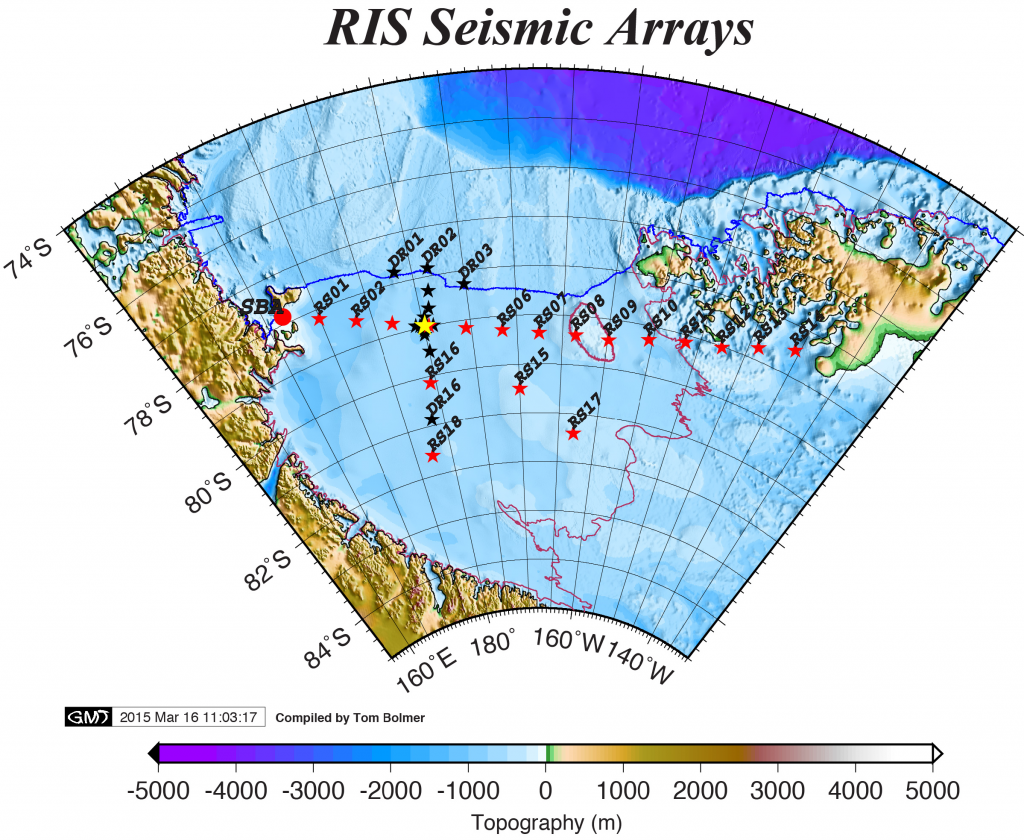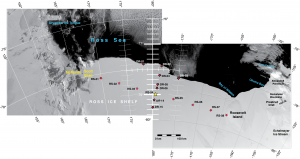Taking the Pulse of the Ross Ice Shelf
Taking the Pulse
Dynamic Response of the Ross Ice Shelf
to Wave-induced Vibrations (DRRIS)
The 800 km (500 mile) wide Ross Ice Shelf is the largest in the Antarctic, a region where the effects of climate change are becoming increasingly apparent. Because ice shelves are in contact with the surrounding ocean, they are especially sensitive to changing environmental conditions. A significant portion of the large mass of land ice in the West Antarctic Ice Sheet (WAIS) is buttressed by the Ross Ice Shelf. If the restraint on glacial flow provided by Ross Ice Shelf buttressing is removed, i.e. the ice shelf collapses, WAIS ice will flow much faster to the sea, accelerating sea level rise.
Ocean waves impacting the front of the Ross Ice Shelf (RIS) send vibrations throughout the ice shelf, much like the beating of a heart sends a detectable pulse throughout the body. As with a pulse, these vibrations can be used to help assess the health -- the stability and structural integrity -- of the ice shelf. The speed the vibrations from direct wave impacts and fracturing (icequakes) travel through the ice shelf much faster than the speed of the ocean swell and infragravity waves that generate them. The vibrations are expected to travel more slowly where the ice is broken, fractured, or crevassed. Some of the wave energy couples with the ice shelf, producing "flexural gravity waves" (Bromirski et al., 2015, 2017) that travel at the speed of the ocean waves producing them, that depends on the thickness and strength of the ice, and the depth of the water below the floating ice shelf. An array of broadband seismometers was deployed on the ice shelf surface during November 2014 to measure the amplitude and speed of these vibrations (and other propagation characteristics) along multiple paths across the Ross Ice Shelf. The data are anticipated to enable us to identify zones and regions of weakness that will assist in determining the spatial variability of ice shelf strength.

Map of the Ross Ice Shelf showing bathymetric relief of the seafloor (blue and white), topography above sea level (green and brown), the ~2005 ice front location (blue line) and the grounding line of shelf (magenta line). The red and black stars are RIS and DRIS locations respectively. SBA is a permanent broadband (GSN )seismic stations on land. The DRIS locations at the front of the shelf appear to be seaward of the ice edge because the edge has moved seaward by ~10km since ~2005. These sites are actually ~2km landward of the present day front. The dense array of stations surrounding Yesterday Camp (yellow star) is shown in more detail in figures below.
The 16-station broadband seismic array was deployed on the Ross Ice Shelf (RIS) during November 2014 to measure the response of the RIS to impacts from ocean swell and infragravity (IG) waves. IG waves and/or swell could provide the required external forcing needed to extend existing fractures or trigger sudden ice shelf collapse. The array will measure the spatial and seasonal variability of the wave-shelf interaction, including both the generation of elastic stress waves and the flexing of the ice shelf. The deployment will provide the first spatially comprehensive data on the response of ice shelves to IG waves, including the mechanical and elastic response of ice shelves to gravity wave forcing, both essential to understanding and modeling ice shelf evolution.
The 3-year project will involve a 24-month period of field observation (continuous data collection) spanning 2 full annual cycles on the Ross Ice Shelf, including the austral winter. The array coverage overlaps with the West Antarctic deep earth structure transverse array of Wiens, Aster, and Nyblade (NSF G-089), oriented roughly parallel to the ice shelf front.
The DRRIS ice-shelf deployment will consist of sixteen stations equipped with broadband seismometers and barometers, including:
-
- Three seismic stations near the RIS front will provide reference response/forcing functions, and measure the variability of the response across the front (DR01-03);
-
- Six stations in a linear seismic array orthogonal to the front, in line with the center station at the front and three Wiens et al. (G-089) stations (DR04-06 and DR14-16);
- Seven stations clustered in a higher density array near the intersection of the Wiens et al. (G-089) transverse linear array and the orthogonal array (DR07-13)
Array processing will be used to identify dominant source locations along the front, and propagation speeds across the combined array.
Compliance analyses will investigate changes in flexural properties away from the front towards the grounding line.
Numerical modeling (time-domain finite-difference) will also be conducted to explore theoretical aspects of gravity wave-induced signal propagation in ice shelves, ranging from swell to IG waves.
Mechanical modeling will complement the TDFD investigations, both using seismometer observations to understand the response of the RIS to gravity wave interactions.









